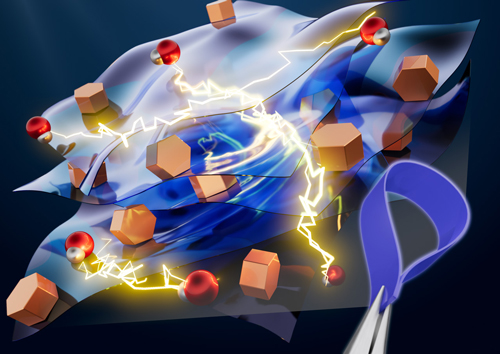- Home
- > Research
- > Research Highlights
- > Vol. 81 Towards Inexpensive and Highly・・・
 Research Highlights
Research Highlights
[Vol. 81]
Towards Inexpensive and Highly Conductive Anion-Exchange Membranes
An international research team at MANA has worked to improve the ionic conductivity of anion-exchange membranes (AEMs) made from layered double hydroxides (LDHs), laying the foundation for their use in many electrochemical applications.

LDHs are inorganic compounds that can be made into extremely thin "nanosheets." These flexible sheets are well-suited to serve as AEMs, which have a wide range of applications, including the manufacture of batteries, water treatment, and electrolysis.
LDHs have ultrahigh ionic conductivity towards hydroxide ions, which facilitates the flow of current. Although LDH nanosheets can reach high levels of ionic conductivity of 10-1 S/cm, this value only affects ions moving in the in-plane direction; that is, along the nanosheet. In contrast, their ionic conductivity through the nanosheet --in the cross-plane direction-- is about 10-6 S/cm, which is five orders of magnitude lower. This hinders fast ionic conduction across AEMs comprising restacked LDH nanosheets.
Fortunately, a research team from MANA, led by Prof. Renzhi Ma, has now found a solution to this problem. They used a simple vacuum-assisted filtration process to combine LDH nanosheets with LDH nanoparticles, producing a hybrid composite membrane. This membrane exhibited high ionic conductivity in both the in-plane and cross-plane directions.
The researchers proposed that introducing nanoparticles reduced the restacking order of the nanosheets. This created diverse ion-conducting pathways in the composite membrane, ultimately boosting its ionic conductivity. "By changing the orientation of the nanosheets, their ultrahigh conductivity along the in-plane was leveraged to achieve fast transmembrane ionic transport," explains Prof. Ma. The composite membrane achieved a conductivity level of 10-2 S/cm (about 10,000 times higher than pure LDH nanosheets) in the cross-plane direction.
Prof. Ma says, "The excellent conductivity of our composite membranes will unlock their potential use as competitive AEMs for platinum-free electrochemical energy storage and conversion." The team's efforts will accelerate the development of less expensive AEMs for next-generation energy and environmental technologies.
LDHs have ultrahigh ionic conductivity towards hydroxide ions, which facilitates the flow of current. Although LDH nanosheets can reach high levels of ionic conductivity of 10-1 S/cm, this value only affects ions moving in the in-plane direction; that is, along the nanosheet. In contrast, their ionic conductivity through the nanosheet --in the cross-plane direction-- is about 10-6 S/cm, which is five orders of magnitude lower. This hinders fast ionic conduction across AEMs comprising restacked LDH nanosheets.
Fortunately, a research team from MANA, led by Prof. Renzhi Ma, has now found a solution to this problem. They used a simple vacuum-assisted filtration process to combine LDH nanosheets with LDH nanoparticles, producing a hybrid composite membrane. This membrane exhibited high ionic conductivity in both the in-plane and cross-plane directions.
The researchers proposed that introducing nanoparticles reduced the restacking order of the nanosheets. This created diverse ion-conducting pathways in the composite membrane, ultimately boosting its ionic conductivity. "By changing the orientation of the nanosheets, their ultrahigh conductivity along the in-plane was leveraged to achieve fast transmembrane ionic transport," explains Prof. Ma. The composite membrane achieved a conductivity level of 10-2 S/cm (about 10,000 times higher than pure LDH nanosheets) in the cross-plane direction.
Prof. Ma says, "The excellent conductivity of our composite membranes will unlock their potential use as competitive AEMs for platinum-free electrochemical energy storage and conversion." The team's efforts will accelerate the development of less expensive AEMs for next-generation energy and environmental technologies.
Reference
“Constructing Fast Transmembrane Pathways in a Layered Double Hydroxide Nanosheets/Nanoparticles Composite Film for an Inorganic Anion-Exchange Membrane”
Fang Xian, Lulu Jia, Yoshiyuki Sugahara, Hairong Xue, Yusuke Yamauchi, Takayoshi Sasaki, and Renzhi Ma.
Journal: ACS Applied Materials and Interfaces 2022, 14, 51212-51221 (November 2, 2022)
DOI : 10.1021/acsami.2c15764
Fang Xian, Lulu Jia, Yoshiyuki Sugahara, Hairong Xue, Yusuke Yamauchi, Takayoshi Sasaki, and Renzhi Ma.
Journal: ACS Applied Materials and Interfaces 2022, 14, 51212-51221 (November 2, 2022)
DOI : 10.1021/acsami.2c15764
Affiliations
International Center for Materials Nanoarchitectonics (WPI-MANA), National Institute for Materials Science (NIMS), Namiki 1-1, Tsukuba, Ibaraki 305-0044, Japan
Contact information
Research Center for Materials Nanoarchitectonics (MANA)
National Institute for Materials Science
1-1 Namiki, Tsukuba, Ibaraki 305-0044 Japan
Phone: +81-29-860-4710
E-mail: mana-pr[AT]nims.go.jp
1-1 Namiki, Tsukuba, Ibaraki 305-0044 Japan
Phone: +81-29-860-4710
E-mail: mana-pr[AT]nims.go.jp

